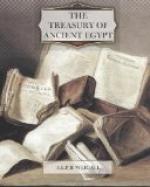Some attempt should be made to rid the science of this forbidding aspect; and for this end students ought to do their best to make it possible for them to be regarded as ordinary, normal, healthy men. Let them discourage the popular belief that they are prodigies, freaks of mental expansion. Let their first desire be to show themselves good, useful, hardy, serviceable citizens or subjects, and they will do much to remove the stigma from their profession. Let them be acquainted with the feeling of a bat or racket in the hands, or a saddle between the knees; let them know the rough path over the mountains, or the diving-pool amongst the rocks, and their mentality will not be found to suffer. A winter’s “roughing it” in the Theban necropolis or elsewhere would do much to banish the desire for perpetual residence at home in the west; and a season in Egypt would alter the point of view of the student more considerably than he could imagine. Moreover, the appearance of the scholar prancing about upon his fiery steed (even though it be but an Egyptian donkey) will help to dispel the current belief that he is incapable of physical exertion; and his reddened face rising, like the morning sun, above the rocks on some steep pathway over the Theban hills will give the passer-by cause to alter his opinion of those who profess and call themselves Egyptologists.
As a second argument a subject must be introduced which will be distasteful to a large number of archaeologists. I refer to the narrow-minded policy of the curators of certain European and American museums, whose desire it is at all costs to place Egyptian and other eastern antiquities actually before the eyes of western students, in order that they and the public may have the entertainment of examining at home the wonders of lands which they make no effort to visit. I have no hesitation in saying that the craze for recklessly bringing away unique antiquities from Egypt to be exhibited in western museums for the satisfaction of the untravelled man, is the most pernicious bit of folly to be found in the whole broad realm of archaeological misbehaviour.
A museum has three main justifications for its existence. In the first place, like a home for lost dogs, it is a repository for stray objects. No curator should endeavour to procure for his museum any antiquity which could be safely exhibited on its original site* and in its original position. He should receive only those stray objects which otherwise would be lost to sight, or those which would be in danger of destruction. The curator of a picture gallery is perfectly justified in purchasing any old master which is legitimately on sale; but he is not justified in obtaining a painting direct from the walls of a church where it has hung for centuries, and where it should still hang. In the same way a curator of a museum of antiquities should make it his first endeavour not so much to obtain objects direct from Egypt as to gather in those antiquities which are in the possession of private persons who cannot be expected to look after them with due care.




